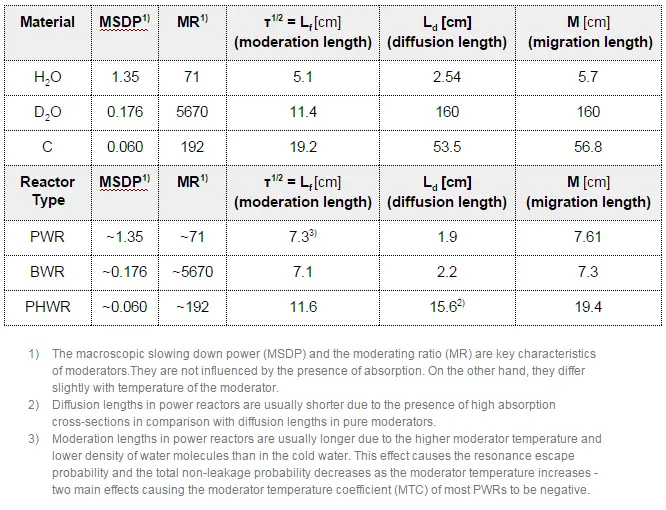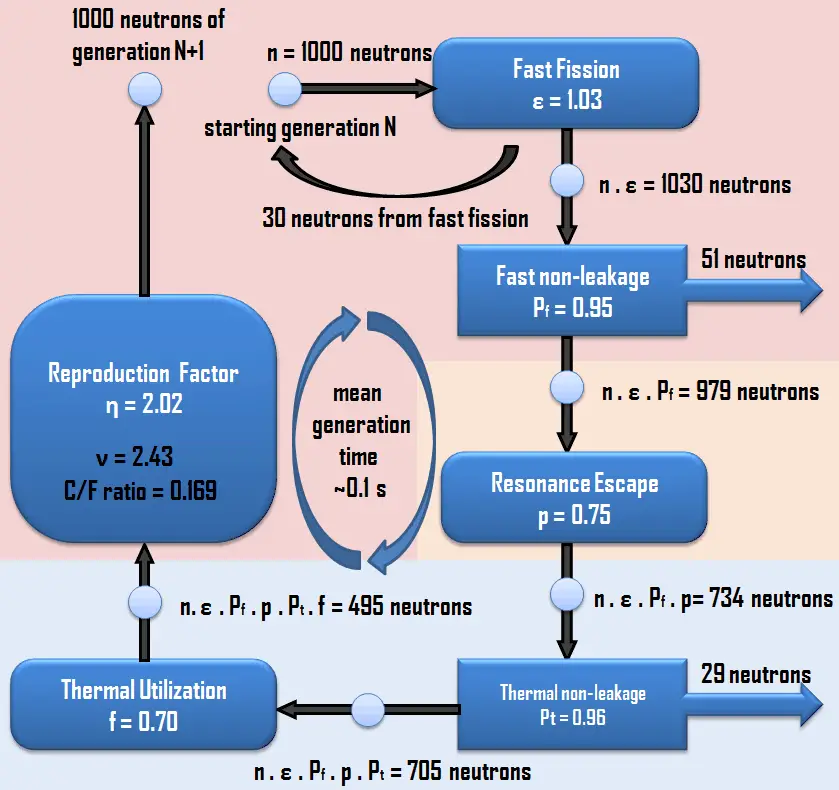Detailed knowledge of all possible operational factors that may affect the multiplication factor of the system is of importance in reactor control. It was stated the keff is during reactor operation kept as near to the value of 1.0 as possible. Many factors influence the criticality of the reactor. For illustration, in an extreme case, the presence of humans (due to the water, carbon, which are good neutron moderators) near fresh uranium fuel assembly influences the multiplication properties of the assembly.
If any operational factor changes one of the contributing factors to keff (keff = η.ε.p.f.Pf.Pt), the ratio of 1.0 is not maintained, and this change in keff makes the reactor either subcritical or supercritical. In most cases, each operational change influences all coefficients in the six-factor formula, but there is always a dominant effect that can be separated. For illustration, here are some examples of these operational changes and their impacts on keff that may take place in PWRs.
Control rods (insertion/withdrawal) influence the thermal utilization factor. For example, control rods insertion causes the addition of new absorbing material into the core, and this causes a decrease in thermal utilization.
The thermal utilization factor for heterogeneous reactor cores must be calculated in terms of reaction rates and volumes, for example, by the following equation:
where Σa is the macroscopic absorption cross-section, which is the sum of the capture cross-section and the fission cross-section, Σa = Σc + Σf. The superscripts U, M, P, CR, B, BA, and O, refer to uranium fuel, moderator, poisons, control rods, boric acid, burnable absorbers, etc. The presence of control rods, boric acid, or poisons causes a decrease in neutron utilization, which, in turn, causes a decrease in the multiplication factor.
Compared with the chemical shim, which offset positive reactivity excess in the entire core, with control rods, the unevenness of neutron-flux density in the reactor core may arise because they act locally.
↑boron ⇒ ↓keff = η.ε.p. ↓f .Pf.Pt
The concentration of boric acid diluted in the primary coolant influences the thermal utilization factor. For example, an increase in the concentration of boric acid (chemical shim) causes the addition of new absorbing material into the core, and this causes a decrease in the thermal utilization factor.
The thermal utilization factor for heterogeneous reactor cores must be calculated in terms of reaction rates and volumes, for example, by the following equation:
where Σa is the macroscopic absorption cross-section, which is the sum of the capture cross-section and the fission cross-section, Σa = Σc + Σf. The superscripts U, M, P, CR, B, BA, and O, refer to uranium fuel, moderator, poisons, control rods, boric acid, burnable absorbers, etc. The presence of control rods, boric acid, or poisons causes a decrease in neutron utilization, which, in turn, causes a decrease in the multiplication factor.
Compared with burnable absorbers (long-term reactivity control) or control rods (rapid reactivity control), the boric acid avoids the unevenness of neutron-flux density in the reactor core because it is dissolved coolant homogeneously in the entire reactor core. On the other hand, high concentrations of boric acid may lead to a positive moderator temperature coefficient, which is undesirable. In this case, more burnable absorbers must be used.
Moreover, this method is slow in controlling reactivity. Normally, it takes several minutes to change the boric acid concentration (dilute or borate) in the primary loop. For rapid changes of reactivity, control rods must be used.
↑TM ⇒ ↓keff = η.ε. ↓p .f. ↓Pf . ↓Pt (EOC)
This operational change is very difficult to describe because changes in moderator temperature lead to almost all the coefficients. Major impacts on the multiplication of the system arise from the change of the resonance escape probability and the change of total neutron leakage (see thermal non-leakage probability and fast non-leakage probability).
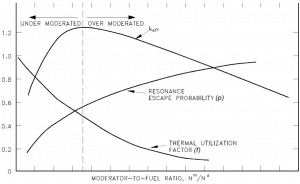 Change of the resonance escape probability. It is known, the resonance escape probability is also dependent on the moderator-to-fuel ratio. All PWRs are designed as under moderated reactors. As the moderator temperature increases, the ratio of the moderating atoms (molecules of water) decreases due to the thermal expansion of water. Its density decreases. This, in turn, causes hardening of neutron spectrum in the reactor core resulting in higher resonance absorption (lower p). The decreasing density of the moderator causes that neutrons stay at a higher energy for a longer period, which increases the probability of non-fission capture of these neutrons. This process is one of two processes, which determine the moderator temperature coefficient (MTC). The second process is connected with the leakage probability of the neutrons. The moderator temperature coefficient must be for most PWRs negative, which improves the reactor stability because reactor core heating causes a negative reactivity insertion.
Change of the resonance escape probability. It is known, the resonance escape probability is also dependent on the moderator-to-fuel ratio. All PWRs are designed as under moderated reactors. As the moderator temperature increases, the ratio of the moderating atoms (molecules of water) decreases due to the thermal expansion of water. Its density decreases. This, in turn, causes hardening of neutron spectrum in the reactor core resulting in higher resonance absorption (lower p). The decreasing density of the moderator causes that neutrons stay at a higher energy for a longer period, which increases the probability of non-fission capture of these neutrons. This process is one of two processes, which determine the moderator temperature coefficient (MTC). The second process is connected with the leakage probability of the neutrons. The moderator temperature coefficient must be for most PWRs negative, which improves the reactor stability because reactor core heating causes a negative reactivity insertion.
-
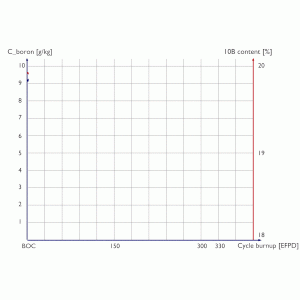
Boron letdown curve (chemical shim) and boron 10 depletion during a 12-month fuel cycle. Change of the thermal utilization factor. The impact on the thermal utilization factor depends strongly on the amount of boron that is diluted in the primary coolant (chemical shim). As the moderator temperature increases, the density of water decreases due to the thermal expansion of water. But along with the moderator also boric acid is expanded out of the core. Since boric acid is a neutron poison, expanding out of the core, positive reactivity is added. The positive reactivity addition due to the expansion of boron out of the core offsets the negative reactivity addition due to the expansion of the moderator out of the core. This effect is significant at the beginning of the cycle (BOC) and gradually loses significance as the boron concentration decreases.
- Change of the neutron leakage. Since both (Pf and Pt) are affected by a change in moderator temperature in a heterogeneous water-moderated reactor and the directions of the feedbacks are the same, the resulting total non-leakage probability is also sensitive to the change in the moderator temperature. As a result, an increase in the moderator temperature causes that the probability of leakage to increase. In the case of the fast neutron leakage, the moderator temperature influences macroscopic cross-sections for elastic scattering reaction (Σs=σs.NH2O) due to the thermal expansion of water, which increases the moderation length. This, in turn, causes an increase in the leakage of fast neutrons.
- For the thermal neutron leakage, there are two effects. Both processes have the same direction and together cause the increase in the thermal neutron leakage. This physical process is a part of the moderator temperature coefficient (MTC).
- Macroscopic cross-sections for elastic scattering reaction Σs=σs.NH2O, which significantly changes due to the thermal expansion of water. As the temperature of the core increases, the diffusion coefficient (D = 1/3.Σtr) increases.
- Microscopic cross-section (σa) for neutron absorption changes with core temperature. As the temperature of the core increases, the absorption cross-section decreases.
- For the thermal neutron leakage, there are two effects. Both processes have the same direction and together cause the increase in the thermal neutron leakage. This physical process is a part of the moderator temperature coefficient (MTC).
Change in the fuel temperature affects primarily the resonance escape probability, which is connected with the phenomenon usually known as the Doppler broadening. The Doppler effect is generally considered to be the most important effect, which improves the reactor stability. Especially in the case of reactivity-initiated accidents (RIA), the Doppler coefficient of reactivity would be the first in the compensation of the inserted positive reactivity. The time for heat to be transferred to the moderator is usually measured in seconds, while the Doppler coefficient is effective almost instantaneously. The Doppler broadening with the process of self-shielding causes that the Doppler coefficient (or the fuel temperature coefficient) is for all power reactors always negative. Therefore an increase in the fuel temperature promptly causes an increase in the resonance integral (Ieff), which, in turn, causes a negative reactivity insertion. It is of the highest importance in reactor safety.
See also: Doppler Broadening.
See also: Self-shielding
Although water is considered incompressible, in reality, it is slightly compressible (especially at 325°C (617°F)). Obviously, the effect of pressure in the primary circuit has similar consequences as the moderator temperature. Compared with the effects of moderator temperature changes, changes in pressure have a lower-order impact on reactivity. The causes are only in the density of the moderator, not in the change of microscopic cross-sections.
The pressure coefficient of reactivity has a slightly positive effect on reactivity as the system’s pressure is increased if. At high boron concentrations, the pressure coefficient may reach negative values, but for many PWRs, it is prohibited to operate under such conditions. Therefore burnable absorbers are usually added to the fuel. They lower the initial boron concentration.
Note: Effects of the nuclate boiling of the primary coolant are not discussed here.
The effect of change in the flow rate through the primary circuit has identical consequences as the effects of the moderator temperature. In reality, when there is an abrupt change (e.g.,, due to a disconnection of the reactor coolant pump) in the flow rate and the reactor power remains the same, the difference between inlet and outlet temperatures must increase. It follows from the basic energy equation of reactor coolant, which is below:
P=↓ṁ.c.↑∆t
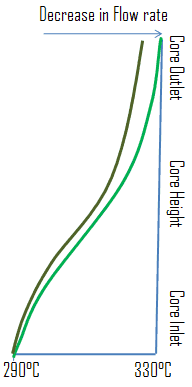 The pressure determines the inlet temperature in the steam generators. Therefore the inlet temperature changes minimally during the transient. It follows the outlet temperature must change significantly as the flow rate changes. When the inlet temperature remains almost the same and the outlet changes significantly, it stands to reason, the average temperature of coolant (moderator) will also change significantly. Therefore the effect of change in the flow rate through the primary circuit has identical consequences as the effects of the moderator temperature.
The pressure determines the inlet temperature in the steam generators. Therefore the inlet temperature changes minimally during the transient. It follows the outlet temperature must change significantly as the flow rate changes. When the inlet temperature remains almost the same and the outlet changes significantly, it stands to reason, the average temperature of coolant (moderator) will also change significantly. Therefore the effect of change in the flow rate through the primary circuit has identical consequences as the effects of the moderator temperature.
The decrease in flow rate is associated with negative reactivity insertion. Special attention is needed in case of an abrupt increase in the flow rate. At normal operation, such an increase in the flow rate can not occur, except for the controlled reactor coolant pump connection, which can be connected only under specific conditions.
In pressurized water reactors, nucleate boiling may occur even during operational conditions. Nucleate boiling occurs when any surface of fuel cladding reaches the saturation temperature (e.g.,, 350°C), determined by the pressure in the pressurizer (e.g.,, 16MPa). Such local nucleate boiling does not pose any problem for the reactor operation.
On the other hand, during abnormal conditions, boiling in the reactor core is one of the most important phenomena that may take place in the core. From the reactivity point of view, nucleate boiling has very important consequences on the reactivity of the reactor core. Boiling affects reactivity in the same manner as the presence of voids, and therefore it is characterized by the void coefficient.
The formation of voids in the core has the same effect as the change in the moderator temperature (change in the density of the moderator). Compared with the change in the moderator temperature, boiling minimally affects the neutron leakage because it is unlikely that local boiling occurs at the periphery of the reactor core, where the local power drops significantly.
↑burnable absorbers ⇒ ↓keff = η.ε.p. ↓f .Pf.Pt
The number of burnable absorbers in the nuclear fuel influences the thermal utilization factor. In some cases (especially in the case of gadolinium absorbers), the presence of burnable absorbers influences all the factors in the four-factor formula due to very high self-shielding effects. But at this place, we consider only the change in the thermal utilization factor. An increase in the number of burnable absorbers causes the addition of new absorbing material into the core, and this causes a decrease in the thermal utilization factor.
The thermal utilization factor for heterogeneous reactor cores must be calculated in terms of reaction rates and volumes, for example, by the following equation:
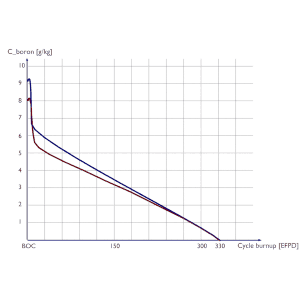
where Σa is the macroscopic absorption cross-section, which is the sum of the capture cross-section and the fission cross-section, Σa = Σc + Σf, the superscripts U, M, P, CR, B, BA, and O, refer to uranium fuel, moderator, poisons, control rods, boric acid, burnable absorbers, and others, respectively. The presence of control rods, boric acid, or burnable absorbers causes a decrease in neutron utilization, which, in turn, causes a decrease of multiplication factors.
It is hard to describe the effects of fuel burnup on the six-factor formula. It must be noted that the criticality must be maintained for a long period. Therefore, all the negative effects must be compensated by increasing the thermal utilization factor (boron dilution or compensating rods withdrawal).
Thermal Utilization Factor
The thermal utilization factor slightly changes with the fuel burnup. The fresh fuel at the beginning of the cycle comprises only the absorption by the 235U. As the amount of 239Pu and other higher transuranic elements increases because of the radiative capture of a neutron by the 238U in the core, it is necessary to consider the change of fuel composition in determining the value of f at different times of the fuel cycle.
In general, the thermal utilization factor decreases as the total content of fissile isotopes decreases and the total content of neutron poisons (fission products with high absorption cross-sections) increases. But in the power reactors, in which the criticality must be maintained for a long period (e.g.,, 12-month or up to 24-month) without refueling, the thermal utilization factor may not decrease. Such a decrease would imply an inevitable reactor shutdown. The continuous decrease in ΣaU must be offset by the continuous decrease in ΣaB, which means the concentration of boric acid (in the case of PWRs) must be continuously decreased as the fuel loses its reactivity (kinf). For reactors in which the chemical shim can not be used, the excess of reactivity is compensated by compensating rods.
Reproduction Factor
There is essentially a small change in η over the lifetime of the reactor core (decreases). This is because there is a continuous decrease in ΣfU, but on the other hand, this decrease is partially offset by the increase in ΣfPu. As the fuel burnup increases, the 239Pu begins to contribute to the neutron economy of the core.
See also: Nuclear Breeding
Neutron Leakage
In power reactors, the total non-leakage probability also significantly changes with fuel burnup. This dependency is not associated with any of the parameters like the diffusion coefficient or the geometrical buckling. In power reactors, the total non-leakage probability depends on the certain fuel loading pattern, and the reload strategy. Neutron leakage is one of the key parameters in the neutron and fuel economy.
In order to enhance the neutron and fuel economy, core designers designs the low leakage loading patterns, in which fresh fuel assemblies are not situated in the peripheral positions of the reactor core. The peripheral positions are loaded with the fuel with highest fuel burnup. These “high” burnup assemblies have inherently lower relative power (due to the lower kinf and due to the fact they feel the presence of non-multiplying environment) in comparison with the average assemblies. In short, this parameter is significantly dependent on the certain loading pattern. During fuel burnup, the neutron leakage usually increases, especially in low leakage loading patterns. This process is caused by reducing the differences in kinf between fresh fuel assemblies and peripheral high-burnup assemblies.
- J. R. Lamarsh, Introduction to Nuclear Reactor Theory, 2nd ed., Addison-Wesley, Reading, MA (1983).
- J. R. Lamarsh, A. J. Baratta, Introduction to Nuclear Engineering, 3d ed., Prentice-Hall, 2001, ISBN: 0-201-82498-1.
- W. M. Stacey, Nuclear Reactor Physics, John Wiley & Sons, 2001, ISBN: 0- 471-39127-1.
- Glasstone, Sesonske. Nuclear Reactor Engineering: Reactor Systems Engineering, Springer; 4th edition, 1994, ISBN: 978-0412985317
- W.S.C. Williams. Nuclear and Particle Physics. Clarendon Press; 1 edition, 1991, ISBN: 978-0198520467
- G.R.Keepin. Physics of Nuclear Kinetics. Addison-Wesley Pub. Co; 1st edition, 1965
- Robert Reed Burn, Introduction to Nuclear Reactor Operation, 1988.
- U.S. Department of Energy, Nuclear Physics and Reactor Theory. DOE Fundamentals Handbook, Volume 1 and 2. January 1993.
Advanced Reactor Physics:
- K. O. Ott, W. A. Bezella, Introductory Nuclear Reactor Statics, American Nuclear Society, Revised edition (1989), 1989, ISBN: 0-894-48033-2.
- K. O. Ott, R. J. Neuhold, Introductory Nuclear Reactor Dynamics, American Nuclear Society, 1985, ISBN: 0-894-48029-4.
- D. L. Hetrick, Dynamics of Nuclear Reactors, American Nuclear Society, 1993, ISBN: 0-894-48453-2.
- E. E. Lewis, W. F. Miller, Computational Methods of Neutron Transport, American Nuclear Society, 1993, ISBN: 0-894-48452-4.

